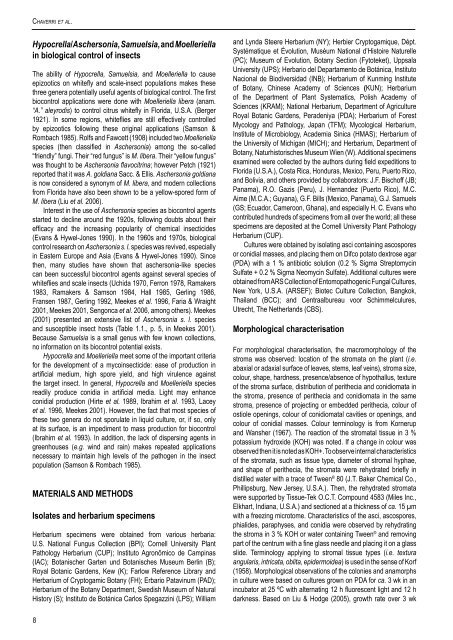Moelleriella, and Samuelsia - CBS
Moelleriella, and Samuelsia - CBS
Moelleriella, and Samuelsia - CBS
- No tags were found...
You also want an ePaper? Increase the reach of your titles
YUMPU automatically turns print PDFs into web optimized ePapers that Google loves.
Ch av e r r i e t a l.Hypocrella/Aschersonia, <strong>Samuelsia</strong>, <strong>and</strong> <strong>Moelleriella</strong>in biological control of insectsThe ability of Hypocrella, <strong>Samuelsia</strong>, <strong>and</strong> <strong>Moelleriella</strong> to causeepizootics on whitefly <strong>and</strong> scale-insect populations makes thesethree genera potentially useful agents of biological control. The firstbiocontrol applications were done with <strong>Moelleriella</strong> libera (anam.“A.” aleyrodis) to control citrus whitefly in Florida, U.S.A. (Berger1921). In some regions, whiteflies are still effectively controlledby epizootics following these original applications (Samson &Rombach 1985). Rolfs <strong>and</strong> Fawcett (1908) included two <strong>Moelleriella</strong>species (then classified in Aschersonia) among the so-called“friendly” fungi. Their “red fungus” is M. libera. Their “yellow fungus”was thought to be Aschersonia flavocitrina; however Petch (1921)reported that it was A. goldiana Sacc. & Ellis. Aschersonia goldianais now considered a synonym of M. libera, <strong>and</strong> modern collectionsfrom Florida have also been shown to be a yellow-spored form ofM. libera (Liu et al. 2006).Interest in the use of Aschersonia species as biocontrol agentsstarted to decline around the 1920s, following doubts about theirefficacy <strong>and</strong> the increasing popularity of chemical insecticides(Evans & Hywel-Jones 1990). In the 1960s <strong>and</strong> 1970s, biologicalcontrol research on Aschersonia s. l. species was revived, especiallyin Eastern Europe <strong>and</strong> Asia (Evans & Hywel-Jones 1990). Sincethen, many studies have shown that aschersonia-like speciescan been successful biocontrol agents against several species ofwhiteflies <strong>and</strong> scale insects (Uchida 1970, Ferron 1978, Ramakers1983, Ramakers & Samson 1984, Hall 1985, Gerling 1986,Fransen 1987, Gerling 1992, Meekes et al. 1996, Faria & Wraight2001, Meekes 2001, Sengonca et al. 2006, among others). Meekes(2001) presented an extensive list of Aschersonia s. l. species<strong>and</strong> susceptible insect hosts (Table 1.1., p. 5, in Meekes 2001).Because <strong>Samuelsia</strong> is a small genus with few known collections,no information on its biocontrol potential exists.Hypocrella <strong>and</strong> <strong>Moelleriella</strong> meet some of the important criteriafor the development of a mycoinsecticide: ease of production inartificial medium, high spore yield, <strong>and</strong> high virulence againstthe target insect. In general, Hypocrella <strong>and</strong> <strong>Moelleriella</strong> speciesreadily produce conidia in artificial media. Light may enhanceconidial production (Hirte et al. 1989, Ibrahim et al. 1993, Laceyet al. 1996, Meekes 2001). However, the fact that most species ofthese two genera do not sporulate in liquid culture, or, if so, onlyat its surface, is an impediment to mass production for biocontrol(Ibrahim et al. 1993). In addition, the lack of dispersing agents ingreenhouses (e.g. wind <strong>and</strong> rain) makes repeated applicationsnecessary to maintain high levels of the pathogen in the insectpopulation (Samson & Rombach 1985).Materials <strong>and</strong> methodsIsolates <strong>and</strong> herbarium specimensHerbarium specimens were obtained from various herbaria:U.S. National Fungus Collection (BPI); Cornell University PlantPathology Herbarium (CUP); Instituto Agronômico de Campinas(IAC); Botanischer Garten und Botanisches Museum Berlin (B);Royal Botanic Gardens, Kew (K); Farlow Reference Library <strong>and</strong>Herbarium of Cryptogamic Botany (FH); Erbario Patavinum (PAD);Herbarium of the Botany Department, Swedish Museum of NaturalHistory (S); Instituto de Botánica Carlos Spegazzini (LPS); William<strong>and</strong> Lynda Steere Herbarium (NY); Herbier Cryptogamique, Dépt.Systématique et Évolution, Muséum National d’Histoire Naturelle(PC); Museum of Evolution, Botany Section (Fytoteket), UppsalaUniversity (UPS); Herbario del Departamento de Botánica, InstitutoNacional de Biodiversidad (INB); Herbarium of Kunming Instituteof Botany, Chinese Academy of Sciences (KUN); Herbariumof the Department of Plant Systematics, Polish Academy ofSciences (KRAM); National Herbarium, Department of AgricultureRoyal Botanic Gardens, Peradeniya (PDA); Herbarium of ForestMycology <strong>and</strong> Pathology, Japan (TFM); Mycological Herbarium,Institute of Microbiology, Academia Sinica (HMAS); Herbarium ofthe University of Michigan (MICH); <strong>and</strong> Herbarium, Department ofBotany, Naturhistorisches Museum Wien (W). Additional specimensexamined were collected by the authors during field expeditions toFlorida (U.S.A.), Costa Rica, Honduras, Mexico, Peru, Puerto Rico,<strong>and</strong> Bolivia, <strong>and</strong> others provided by collaborators: J.F. Bischoff (JB;Panama), R.O. Gazis (Peru), J. Hern<strong>and</strong>ez (Puerto Rico), M.C.Aime (M.C.A.; Guyana), G.F. Bills (Mexico, Panama), G.J. Samuels(GS; Ecuador, Cameroon, Ghana), <strong>and</strong> especially H. C. Evans whocontributed hundreds of specimens from all over the world; all thesespecimens are deposited at the Cornell University Plant PathologyHerbarium (CUP).Cultures were obtained by isolating asci containing ascosporesor conidial masses, <strong>and</strong> placing them on Difco potato dextrose agar(PDA) with a 1 % antibiotic solution (0.2 % Sigma StreptomycinSulfate + 0.2 % Sigma Neomycin Sulfate). Additional cultures wereobtained from ARS Collection of Entomopathogenic Fungal Cultures,New York, U.S.A. (ARSEF); Biotec Culture Collection, Bangkok,Thail<strong>and</strong> (BCC); <strong>and</strong> Centraalbureau voor Schimmelculures,Utrecht, The Netherl<strong>and</strong>s (<strong>CBS</strong>).Morphological characterisationFor morphological characterisation, the macromorphology of thestroma was observed: location of the stromata on the plant (i.e.abaxial or adaxial surface of leaves, stems, leaf veins), stroma size,colour, shape, hardness, presence/absence of hypothallus, textureof the stroma surface, distribution of perithecia <strong>and</strong> conidiomata inthe stroma, presence of perithecia <strong>and</strong> conidiomata in the samestroma, presence of projecting or embedded perithecia, colour ofostiole openings, colour of conidiomatal cavities or openings, <strong>and</strong>colour of conidial masses. Colour terminology is from Kornerup<strong>and</strong> Wansher (1967). The reaction of the stromatal tissue in 3 %potassium hydroxide (KOH) was noted. If a change in colour wasobserved then it is noted as KOH+. To observe internal characteristicsof the stromata, such as tissue type, diameter of stromal hyphae,<strong>and</strong> shape of perithecia, the stromata were rehydrated briefly indistilled water with a trace of Tween ® 80 (J.T. Baker Chemical Co.,Phillipsburg, New Jersey, U.S.A.). Then, the rehydrated stromatawere supported by Tissue-Tek O.C.T. Compound 4583 (Miles Inc.,Elkhart, Indiana, U.S.A.) <strong>and</strong> sectioned at a thickness of ca. 15 µmwith a freezing microtome. Characteristics of the asci, ascospores,phialides, paraphyses, <strong>and</strong> conidia were observed by rehydratingthe stroma in 3 % KOH or water containing Tween ® <strong>and</strong> removingpart of the centrum with a fine glass needle <strong>and</strong> placing it on a glassslide. Terminology applying to stromal tissue types (i.e. texturaangularis, intricata, oblita, epidermoidea) is used in the sense of Korf(1958). Morphological observations of the colonies <strong>and</strong> anamorphsin culture were based on cultures grown on PDA for ca. 3 wk in anincubator at 25 ºC with alternating 12 h fluorescent light <strong>and</strong> 12 hdarkness. Based on Liu & Hodge (2005), growth rate over 3 wk8
















